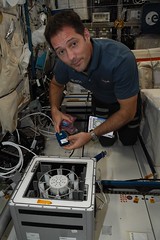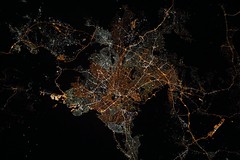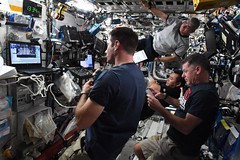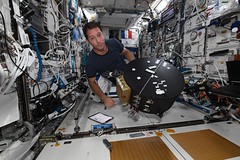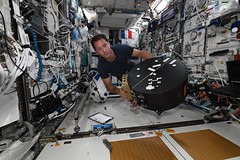C. Elegans
mercredi 9 juin 2021 à 08:44Thomas Pesquet posted a photo:
The second Molecular Muscle Experiment arrived on the International Space Station with SpaceX-22 last Saturday, and it is one of the experiments we had to process immediately. Inside these cartridges are microscopic worms, C. Elegans, that will be monitored in this box called Kubik. The "box" is actually a complicated incubator and centrifuge in one, and a succes of European engineering as it has been on the Space Station for over a decade and just works. Like with many experiments they sound more interesting than they are visually. We cannot see the worms as they are microscopic and inside sealed cartridges. They will grow over five days to find out more about how their muscles adapt to weightlessness. C. Elegans worms share 80% of their genes with us humans and researchers on this @esa/@UKSA experiment hope to pinpoint what genes cause muscle decay – with the aim to develop drugs to limit muscle decay.
Nous avons reçu la V2 de l’expérience Molecular Muscles (MME) samedi dernier, lors du ravitaillement du cargo Dragon. Il a fallu s’en occuper immédiatement : ces cartouches contiennent des vers microscopiques ! Ils s’appellent C. Elegans et sont est très utilisés par les chercheurs. Nous les avons mis en sécurité dans KUBIK qui est à la fois un incubateur et une centrifugeuse en un seul appareil. C'est un très bel outil européen qui se trouve à bord de la station spatiale depuis plus de dix ans et qui fonctionne toujours parfaitement. Comme beaucoup d'expériences, MME n’est pas très impressionnante visuellement : on ne peut pas voir les vers car ils sont microscopiques et se trouvent dans des cartouches scellées. En revanche, comme beaucoup d’expériences, son objectif est fascinant. Dans les jours qui viennent, ils vont grandir et vieillir, et lorsqu’ils redescendront sur Terre, les chercheurs pourront étudier comment leurs muscles se sont adaptés à l'apesanteur. C. Elegans partage 80 % de ses gènes avec les humains, et les chercheurs de l'expérience @esa/@UKSA espèrent identifier ceux qui sont responsables de la dégradation des muscles. Comme souvent, le but est de développer des médicaments pour contrer ce problème :thumbs up:
Credits: ESA/NASA–T. Pesquet
423F1439 Thomas with MME
